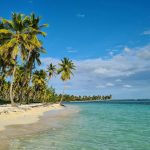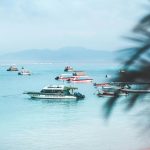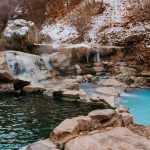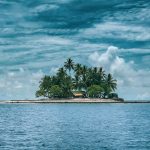Table of Contents
Last month, while everyone lined up to photograph marine iguanas on Isabela Island’s main beach, I was swimming with a playful pod of wild dolphins at a hidden cove just 15 minutes away. That’s the thing about the Galapagos – the real magic happens where the tour buses don’t go.
1. Caleta Tortuga Negra (Black Turtle Cove)
Most visitors skip this spot entirely, but it’s easily the best place to see baby sharks in the Galapagos. Hidden in Santa Cruz’s mangroves, this peaceful lagoon serves as a natural nursery for blacktip reef sharks. I once counted 23 shark pups gliding through the crystal-clear water during a single morning kayak trip. The secret? Visit during high tide, and keep your movements slow and quiet. The local fishermen taught me to look for tiny ripples on the surface – that’s usually where you’ll find the shark nurseries.
2. Las Grietas’ Secret Pool
Everyone visits the first pool at Las Grietas, but hardly anyone knows about the third one. You’ll need to scramble over some rocks and squeeze through a narrow crack in the cliff (hence the name “The Cracks”), but what awaits is worth it. This hidden swimming hole has the clearest water I’ve ever seen in the Galapagos. Last week, I spotted a sea turtle resting at the bottom – something that’s never happened in the main tourist pool. Bring water shoes and go early; the rocks get slippery and hot by midday.
3. Cerro Brujo’s Hidden Beach
San Cristóbal Island has dozens of beaches, but this one’s special. Most tours skip it because it’s only accessible during certain tides. Time it right, and you’ll find yourself on a pristine white sand beach with ancient lava formations that look like modern art sculptures. The real treat? This is one of the few places where you can regularly spot both sea lions and penguins hanging out together. My daughter calls it the “animal party beach” because it feels like all the Galapagos wildlife decided to meet up here.
4. The Secret Side of Kicker Rock
Leon Dormido (Kicker Rock) is famous for its snorkeling channel, but there’s a lesser-known spot on its north face that blows it away. You’ll need to convince a local boat captain to take you (I recommend asking for Carlos at the San Cristóbal dock), but it’s worth the extra effort. This is where hammerhead sharks gather in groups of 20 or more during the cold season. The currents can be strong, but the visibility often exceeds 100 feet. Last month, we saw a group of hammerheads hunting alongside a pod of dolphins – something I’d never witnessed in 15 years of living here.
5. The Hidden Flamingo Pools of Floreana
Everyone knows about the flamingo lagoon on Isabela, but Floreana Island holds a secret: a series of hidden salt pools where flamingos gather in much larger numbers.
You won’t find these pools on any tourist map. They’re about a 40-minute walk from Puerto Velasco Ibarra, past the olivine beach. The local school teacher, Maria, first showed me this spot. She’s been counting the flamingos here every morning for the past decade. Her records show more flamingos here than at any other location in the archipelago.
6. Post Office Bay’s Underwater Cave
Post Office Bay is famous for its mail barrel tradition, but most people miss the underwater cave system nearby. During low tide, you can swim into these lava tubes that extend nearly 100 feet inland. The caves are home to sleeping white-tipped reef sharks during the day. Bring an underwater flashlight, and you might spot some of the endemic Galapagos cardinalfish that hide in the cave’s darker corners. Just don’t tell the tour groups – this is one of the last places where you can still have a truly private wildlife encounter.
7. The Secret Viewpoint of Bartolomé
Everyone photographs Bartolomé Island from the famous stairs, but there’s a little-known trail that leads to an even better viewpoint. It’s a challenging 20-minute climb over loose volcanic rock, but the panorama includes both the classic Pinnacle Rock shot and the hidden southern bays where penguins nest. I’ve taken some of my best sunset photos here, especially when the clouds turn pink and reflect in the perfectly still waters below.
8. Punta Espinoza’s Hidden Lagoon
This spot on Fernandina Island is my favorite place in the entire archipelago. Behind the main marine iguana colonies, there’s a hidden lagoon that’s only accessible through a small break in the mangroves. You’ll have to time your visit with high tide and crawl through a natural tunnel, but what awaits is incredible: a pristine pool where sea turtles, marine iguanas, and flightless cormorants gather to feed and rest. Even better? The surrounding rocks create perfect natural seating for wildlife watching.
9. The Real Darwin’s Arch
Everyone knows Darwin’s Arch collapsed in 2021, but what they don’t know is that there’s an even more impressive natural arch just around the corner. Local dive masters call it “The New Arch,” and it’s a better spot for seeing schooling hammerheads and whale sharks during the season. The catch? You’ll need to book with a dive operator who knows exactly where it is – many still don’t include it in their routes.
10. Tagus Cove’s Ancient Cave Art
This historic anchorage on Isabela Island holds a secret that even many guides don’t know about. While tourists snap photos of the graffiti left by whalers and pirates in the 1800s, there’s a much older art gallery hidden in a nearby cave. These petroglyphs were likely carved by early visitors to the islands, long before Darwin arrived. The local park rangers recently found what they believe to be indigenous Ecuadorian markings dating back several centuries.
The Real Galapagos Still Exists
The Galapagos you see in documentaries – the one without the crowds and gift shops – is still out there. You just need to know where to look. Yesterday, my son asked me if the islands were more exciting back when I first moved here. I showed him the hidden lagoon at Punta Espinoza. His eyes got wide, just like mine did 15 years ago. Some places never lose their magic.

I’m Garrett, a seasoned photojournalist with a passion for uncovering the world’s hidden treasures. My journey is fueled by a deep curiosity for diverse cultures and breathtaking landscapes. When I’m not behind the lens capturing the world’s wonders, you can find me exploring underwater realms or sharing my passion for discovery with my two adventurous children.




